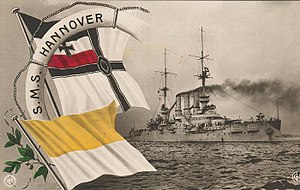SMS Hannover: Difference between revisions
Carabaopower (talk | contribs) |
Carabaopower (talk | contribs) |
||
| Line 59: | Line 59: | ||
==Service== |
==Service== |
||
During the [[First World War]], despite being outdated by the time, the ''Hannover'' together with her sisters ''Schlesien'', ''Pommern'', ''Deutschland'', and ''Schleswig-Holstein'' took part in the [[Battle of Jutland]] on [[31 |
During the [[First World War]], despite being outdated by the time, the ''Hannover'' together with her sisters ''Schlesien'', ''Pommern'', ''Deutschland'', and ''Schleswig-Holstein'' took part in the [[Battle of Jutland]] on [[31 May]] [[1916]] as part of the 2nd Battle Squadron of the German [[High Seas Fleet]] under [[Vice-Admiral]] [[Reinhard Scheer]]. During Jutland she fired a total of eight 28 cm and twenty-two 17 cm shells, and remained undamaged. The ''Pommern'' sank during the battle. |
||
After Jutland she was sent to [[Kiel]] on 4 November]] [[1916]] for repairs and refits, and she waas used as a target ship in the [[Baltic Sea]]. In [[March]] [[1917]] some of her guns were removed, and the ''Hannover'' was relegated to guard duty and coastal defence for the remainder of the First World War. |
|||
After Jutland and for the remainder of the First World War, the ''Hannover'' was relegated to guard duty and coastal defence. After World War I, under the terms of the [[Treaty of Versailles]] Germany was allowed to keep her obsolescent warships, and this included the ''Hannover.'' She continued in sevice with the German Weimar Navy until [[1935]], when she was stricken off the active rolls. She was held in reserve for conversion to a target ship for aircraft, but this was never carried out. |
|||
After World War I, under the terms of the [[Treaty of Versailles]] Germany was allowed to keep her obsolescent warships, and this included the ''Hannover''; owing to budgetary constriants she was decommissioned on [[17 December]] [[1918]]. Modernized in [[Wilhelmshaven]] from [[1920]] to [[1921]], she was again commissioned as the flagship of German naval forces in the Baltic in [[June]] [[1921]]. She continued in sevice with the German Weimar Navy until [[25 September]] [[1931]], when she was stricken off the active rolls. She was held in reserve for conversion into a remote-controlled target ship for aircraft, but this was never carried out. The ''Hannover'' was instead used for explosive tests and scrapped in [[Bremerhaven]] from [[1944]] to [[1946]]. |
|||
The ''Hannover'' was scrapped in [[Bremerhaven]] from [[1944]] to [[1946]]. |
|||
==References== |
==References== |
||
Revision as of 09:43, 16 August 2007
 SMS Hannover in 1906. | |
| Career | |
|---|---|
| Builder: | Kaiserliche Werft Wilhelmshaven |
| Ordered: | |
| Laid down: | 7 November 1904 |
| Launched: | 29 September 1905 |
| Commissioned: | 1 October 1907 |
| Fate: | |
| General characteristics | |
| Displacement: | 13,200t standard; 14,218t full load |
| Dimensions: | 127.6 m x 22.2 m x 7.7 m |
| Armament at construction | Four 280 mm (2 × 2) Fourteen 170 mm (casemated) Twenty-two 86 mm (casemated) Six 450 mm torpedo tubes |
| Armament in 1939: | Four 280 mm (2×2) Two 88 mm Four 37 mm (2×2) Twenty-two 20 mm cannon |
| Armor protection: | 230 mm in belt 280 mm in turrets 76 mm in deck |
| Aircraft: | None |
| Propulsion: | 19,330 hp = 19.1 kts |
| Crew: | 743 |
SMS Hannover was a Deutschland class pre-dreadnought of the Deutsches Kaiserliche Marine and she was the second ship of the class. She was named after the State of Hannover of Germany in Lower Saxony.
Construction
Built by the Kaiserliche Werft at their shipyards in Wilhelmshaven, the keel of the Hannover was laid down on 7 November 1904 and she was launched on 29 September 1905. On completion she was commissioned on 1 October 1907.
The Hannover and her sister ships the SMS Deutschland, SMS Pommern, SMS Schlesien and SMS Schleswig-Holstein represented Germany’s last pre-dreadnought battleships. They were similar in general type to the Braunschweig class battleship immediately preceding them, although the Deutschlands were more heavily armoured. The practice of fitting a type of intermediate calibre artillery common in other powers' navies was not followed in the German Navy due to the difficulty in controlling the firing and in spotting the fall of shot from three different sizes of guns.
Service
During the First World War, despite being outdated by the time, the Hannover together with her sisters Schlesien, Pommern, Deutschland, and Schleswig-Holstein took part in the Battle of Jutland on 31 May 1916 as part of the 2nd Battle Squadron of the German High Seas Fleet under Vice-Admiral Reinhard Scheer. During Jutland she fired a total of eight 28 cm and twenty-two 17 cm shells, and remained undamaged. The Pommern sank during the battle.
After Jutland she was sent to Kiel on 4 November]] 1916 for repairs and refits, and she waas used as a target ship in the Baltic Sea. In March 1917 some of her guns were removed, and the Hannover was relegated to guard duty and coastal defence for the remainder of the First World War.
After World War I, under the terms of the Treaty of Versailles Germany was allowed to keep her obsolescent warships, and this included the Hannover; owing to budgetary constriants she was decommissioned on 17 December 1918. Modernized in Wilhelmshaven from 1920 to 1921, she was again commissioned as the flagship of German naval forces in the Baltic in June 1921. She continued in sevice with the German Weimar Navy until 25 September 1931, when she was stricken off the active rolls. She was held in reserve for conversion into a remote-controlled target ship for aircraft, but this was never carried out. The Hannover was instead used for explosive tests and scrapped in Bremerhaven from 1944 to 1946.
